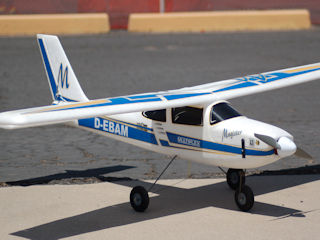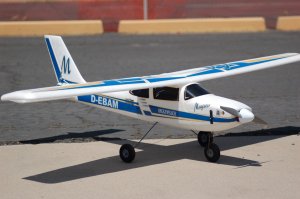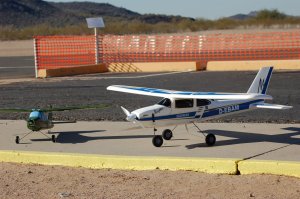


The Multiplex Magister was my first large model with wheels! It is a 40-size trainer that comes in an RTF kit with radio and geared 680 motor. In its kit form it can take several brushless electric motors or a .25 to .32 glow motor.
The kit includes two formed foam nose pieces to choose from depending on the motor you choose.
 Like all Multiplex Elapor foam kits, it has relatively few pieces and goes together with regular CA. Control “snakes” are routed along the outside of the fuselage in molded grooves with servos mounted in recessed opening in the fuselage side. The ailerons are controlled by a single servo with a clip mount in one of the holes in a round actuating wheel. The instructions claim this is to allow you to separate the two wing halves for transport. It seemed pretty fragile to me so while I use it, I don’t separate the wing halves. Several message threads on the major message boards have comments about using dual servos with one controlling each aileron. The foam wing would make this a pretty easy mod.
Like all Multiplex Elapor foam kits, it has relatively few pieces and goes together with regular CA. Control “snakes” are routed along the outside of the fuselage in molded grooves with servos mounted in recessed opening in the fuselage side. The ailerons are controlled by a single servo with a clip mount in one of the holes in a round actuating wheel. The instructions claim this is to allow you to separate the two wing halves for transport. It seemed pretty fragile to me so while I use it, I don’t separate the wing halves. Several message threads on the major message boards have comments about using dual servos with one controlling each aileron. The foam wing would make this a pretty easy mod.
I’ve painted a number of my Multiplex models so I’ve sanded them with very fine sandpaper to take off the small dimples from the molding process. Since I didn’t plan on painting the Magister, this proved to be a mistake. Elapor foam has a very smooth and shiny surface. Not good for paint but excellent for attaching the nice decals included with Multiplex kits. Even light sanding results in a bit of a fuzzy surface which has caused some loosening of the decals. I find paint sticks better with sanding but not the sticky decals placed directly on the foam.
My motor choice was an AXI 2820/12 brushless motor. It mounted cleanly on the included motor mount. I’ve powered it with a pair of 2100mAh 11.1 volt lipos linked with a parallel connector cable. The prop is an APC 12X6 thin electric. A plastic spinner tops it off. This combination gives me 9 – 10 minute flights adding about 1500mAh back to the batteries as shown on my Prodigy II charger. Here are some key statistics.
| Wingspan | 64.2 inches |
| Fuselage | 46 inches |
| Weight | 5.2 pounds |
| Battery | 2 - 11.1v 2100mAh in parallel |
Take a look at the Magister manual here.

The Magister has exceeded my expectations. It has proved to be a rugged trainer for me to practice take-offs and landings. Since my other planes are hand launched and land on their bellies, I needed some practice on my ground-control skills.
The power of the Axi allows for a fairly short takeoff. On a couple of occasions I’ve poured the coals to it to jump into the air as I was starting to get into a back and forth PIO (pilot induced oscillation). It has also allowed me to abort some squirrely landings fairly late in the process to go around and try again. The mounting of the nose gear has also been helpful in the learning process. There have been a couple of occasions where the nose gear either hit hard or hit first. The result was a quick stop and a twisted nose gear. The fix is easy. Simply loosen the grub screws and reposition the gear. Retighten and you’re good to go. No broken connections, mounting brackets or fuselage structure. I’m sure a couple of the “firm” landings I’ve encountered would have ended flying for the day with a less durable model with traditional balsa construction.
This motor set-up also allows for easy basic aerobatics. Loops and rolls are easily accomplished even with low control throws. I’ve noticed a couple of times where the Elapor wings really flex so I watch the high Gs. I plan on adding some carbon rods to the wings in addition to the main wing spar but haven’t done it yet. Since I don’t plan on a lot of aerobatics with the Magister, it may be a while.
Gathering stick time with the Magister is a joy. Being a larger model with good power, it handles the wind well. Weighing around 5 pounds you’ll notice the difference from some of the smaller Multiplex models. Bigger and heavier translates into smoother and steadier. I try to be considerate of the folks flying bigger faster models at my flying field so I plan my trips during anticipated slow times so my smaller slower electric models don’t cause too much of a problem. With the Magister I don’t have to worry about that. It’s the same size and speed of any 40 size model so it fits in like any other “traditional” trainer.
My next add to the Magister is a switch to the receiver. My ESC with BEC has no trouble with the servo loads but did not come with an integrated on/off switch. Since you access the battery and make the ESC connections in the nose, avoiding the prop can be problematic. I’m very careful when connecting the battery but the risk of injury due to unexpected prop rotation still exists. The big prop and powerful Axi could do significant damage. Spring for an inline switch if your ESC doesn’t have one.
If you are looking for an aileron trainer after spending some time with a 3 channel such as the Easy Star, or are just starting out with a club instructor, the Magister would be a great choice. The RTF version with the brushed motor has gotten some good reviews if you’re looking for an all in one package. If you already have a radio and some of the other field supplies, however, do yourself a favor and go with the plain Magister kit and brushless motor. You’ll be glad you did.


